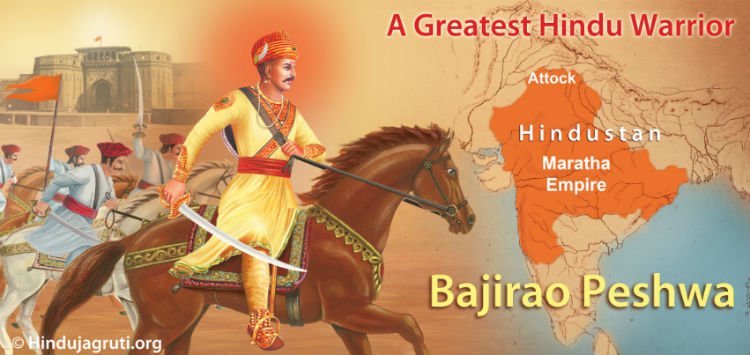Peshwa Baji Rao 1: who made Aurangzeb regret being involved in War


Due to Aurangzeb’s weak heirs, the Mughal Throne’s imperial power waned after his death. “Aurangzeb regretted being involved in the Maratha War”, wrote the Italian traveler Manucci. Each year in this battle, over 100,000 people have perished, and over 300,000 animals—horses, pack animals, and camels—have perished.
On April 17, 1720, around 13 years after the demise of Aurangzeb, Baji Rao, the eldest son of Balaji Vishwanath, who was about twenty years old, succeeded him. Baji Rao was incredibly passionate about his country, and a military genius at a very young age.
His father taught him how to be a diplomat and a fighter. He was educated in reading, writing, and Sanskrit because he was born into a Brahmin family.
He did not, however, confine himself to his books. From an early age, Baji Rao showed a love of the military and frequently accompanied his father on military operations.
He got enough exposure to the Mughal Court during a trip to Delhi with his father in 1719 to recognize its flaws.
Young Baji Rao was too intelligent to ignore the benefit such a circumstance afforded him. The parties eager to rule at the Court were competing with one another for Maratha’s cooperation. Early on, he saw that the Mughul empire was on the verge of extinction and that his people should invade Hindustan in order to acquire absolute control rather than being limited to their Deccan country.
His early actions and his significant victory over the Nizam at Palkhed established his status at home and boosted his confidence and resources.
The Maratha Empire Peshwa, Baji Rao I, and the Nizam-ul-Mulk, Asaf Jah I of Hyderabad engaged in battle on February 28, 1728, in the village of Palkhed, close to the city of Nashik. The Marathas ultimately prevailed.
In “A History of Warfare” (1968), Field Marshal Montgomery, who played a key role in the downfall of Hitler and the destruction of his war machine, recounts some of the significant conflicts waged from ancient times to the present.
The Palkhed expedition of 1727–1728, in which Baji Rao I outgeneraled Nizam–ul–Mulk, is a masterpiece of strategic mobility, he specifically wrote. Baji Rao’s army was entirely mounted, with certain divisions only carrying sabers, lances, and bows.”
My valiant race is on point of extinction. Come and save my honor, O Baji Rao.” When Bajirao arrived to help Chhatrasal, Bangash was defeated along with his son and was forced to leave, signing an agreement that “he would never attack Bundelkhand again”.
Raja Chhatrasal overthrew the Mughal Empire in Bundelkhand and founded a separate kingdom. A Mughal army under Muhammad Khan Bangash besieged his fort and family in December 1728 after attacking him. Chhatrasal often asked Baji Rao for help, but he was in Malwa at the time. He made a comparison between his desperate predicament and Gajendra Moksha. Chhatrasal said the following in a letter to Baji Rao: “Know you that I am in the same tragic situation as the legendary elephant was when trapped by the crocodile.
The authority of Chhatrasal over Bundelkhand was reinstated.
On April 28, 1740, a Monday, Baji Rao passed away. At Raver on the south bank of the Narmada, he passed away unexpectedly. . It was the first illness he had ever experienced in his disease-free life when he fell ill the previous Friday.
The Shaniwar Palace, which serves as Bajirao’s everlasting memorial, is located in Poona. Unfortunately, all that is left now is a bare, empty, desolate plaza.
G.S Sardesai mentions, “Bajirao stands next only to Shivaji in military genius. Twenty years spent in breathless activity and tireless journeys across the Indian continent from Srirangpattan to Delhi and from Ahmadabad to Haidarabad. wore out the iron constitution of this great man of action.
The twenty years of his active career witnessed a complete revolution in the character of the Maratha State and an entire redistribution of political power throughout India.”
The Shaniwar Palace, which serves as Bajirao’s everlasting memorial, is located in Poona. Unfortunately, all that is left now is a bare, empty, desolate plaza.
Thus, a letter written in modern Marathi describes Bajirao’s accomplishment:
“Along with his father’s blessing, Bajirao inherited from him the great task of regeneration that he had undertaken and he spent his life’s effort in accomplishing it. viz., to bring peace and prosperity to the country, north of the Narmada as had been done to the territories south of that river. Bajirao tried to restore the Hindu religion to its former grandeur. It was his ambition to rebuild the great shrine of Kashivishveshwar at Benares. In these efforts, he outshone his father to a far higher degree. He possessed uncommon valor and his fame spread widely as a re-creator of his nation.”
Sources:
1)Maratha Supremacy by R.C Majumdar (GE)
2)New History of Marathas VOL II G.S. Sardesai
3) Twitter: https://twitter.com/HinduHistory108/status/1473503299445788674
DISCLAIMER: The author is solely responsible for the views expressed in this article. The author carries the responsibility for citing and/or licensing of images utilized within the text.
